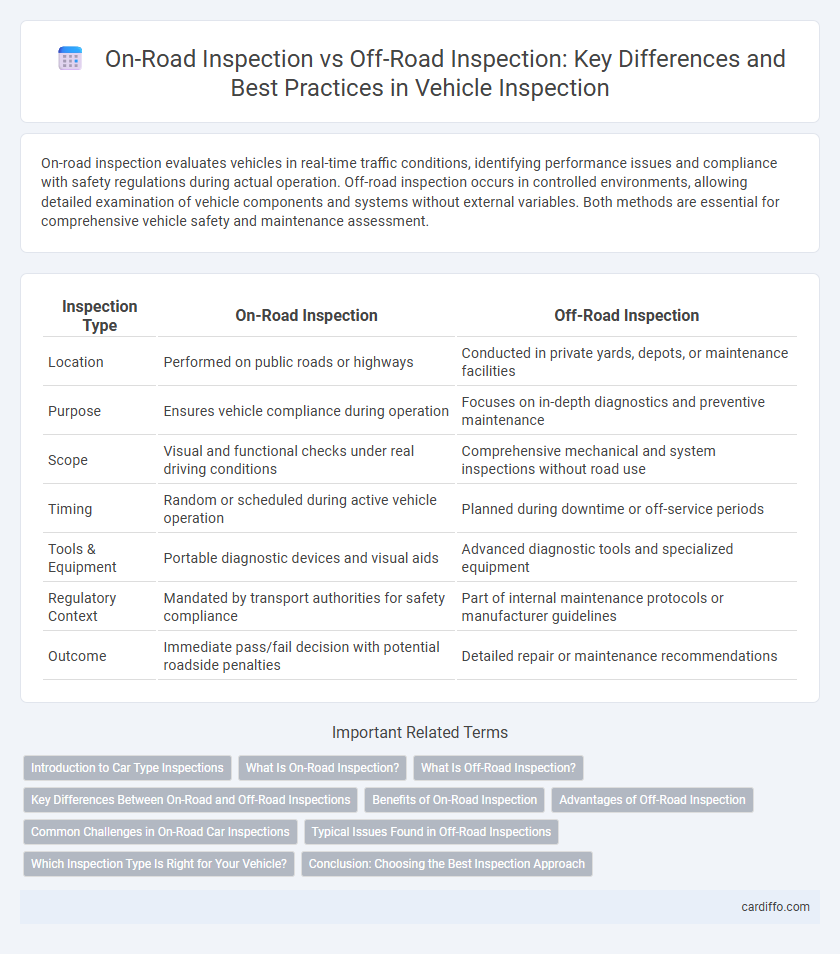On-road inspection evaluates vehicles in real-time traffic conditions, identifying performance issues and compliance with safety regulations during actual operation. Off-road inspection occurs in controlled environments, allowing detailed examination of vehicle components and systems without external variables. Both methods are essential for comprehensive vehicle safety and maintenance assessment.
Table of Comparison
| Inspection Type | On-Road Inspection | Off-Road Inspection |
|---|---|---|
| Location | Performed on public roads or highways | Conducted in private yards, depots, or maintenance facilities |
| Purpose | Ensures vehicle compliance during operation | Focuses on in-depth diagnostics and preventive maintenance |
| Scope | Visual and functional checks under real driving conditions | Comprehensive mechanical and system inspections without road use |
| Timing | Random or scheduled during active vehicle operation | Planned during downtime or off-service periods |
| Tools & Equipment | Portable diagnostic devices and visual aids | Advanced diagnostic tools and specialized equipment |
| Regulatory Context | Mandated by transport authorities for safety compliance | Part of internal maintenance protocols or manufacturer guidelines |
| Outcome | Immediate pass/fail decision with potential roadside penalties | Detailed repair or maintenance recommendations |
Introduction to Car Type Inspections
On-road inspection evaluates vehicles during actual driving conditions, assessing performance, safety features, and emissions in real-time environments. Off-road inspection occurs in controlled settings like garages or inspection centers, focusing on mechanical components, structural integrity, and compliance with regulatory standards. Both inspection types are essential for comprehensive car type assessments, ensuring adherence to safety and environmental regulations across various vehicle categories.
What Is On-Road Inspection?
On-road inspection refers to the examination of vehicles while they are actively operating on public roads to ensure compliance with safety and environmental regulations. This type of inspection typically involves checking emissions, mechanical condition, and safety features under real-world driving conditions. On-road inspections help identify operational issues that might not be evident during stationary or off-road inspections, enhancing overall road safety and environmental protection.
What Is Off-Road Inspection?
Off-road inspection refers to the evaluation and testing of vehicles, equipment, or machinery conducted away from public roads or highways, typically in controlled environments such as test tracks, construction sites, or private facilities. This type of inspection focuses on performance under specific operational conditions, mechanical integrity, and safety compliance without interference from traffic or road regulations. Off-road inspections are essential for heavy-duty vehicles, agricultural machinery, and specialized equipment where on-road conditions do not accurately represent their operational environment.
Key Differences Between On-Road and Off-Road Inspections
On-road inspections primarily evaluate vehicle compliance with traffic safety regulations under real driving conditions, focusing on factors such as brake performance, tire condition, and emissions testing. Off-road inspections concentrate on assessing vehicle components and operational safety in controlled environments, emphasizing mechanical integrity and equipment functionality without the variable conditions of road use. The key differences lie in the inspection setting, specific safety criteria enforced, and the types of performance metrics evaluated for regulatory compliance and operational readiness.
Benefits of On-Road Inspection
On-road inspection enables real-time assessment of vehicle performance under actual driving conditions, improving the accuracy of fault detection and safety evaluations. It minimizes downtime by allowing inspections without removing the vehicle from service, enhancing operational efficiency for fleet management. This approach also facilitates immediate corrective actions, reducing the risk of accidents and costly repairs.
Advantages of Off-Road Inspection
Off-road inspection offers a controlled environment that eliminates traffic risks and distractions, enhancing safety for inspectors and equipment operators. It allows for more thorough examinations with specialized tools and diagnostic devices that may be impractical during on-road checks. Off-road inspections also provide flexible scheduling, reducing operational disruptions and ensuring compliance without affecting vehicle availability.
Common Challenges in On-Road Car Inspections
On-road car inspections often face challenges such as variable traffic conditions, limited space for thorough examinations, and safety concerns for inspectors conducting checks roadside. Weather conditions and inconsistent vehicle behavior during active driving further complicate accurate assessment. These factors make on-road inspections less controlled compared to off-road environments, impacting the consistency and reliability of inspection results.
Typical Issues Found in Off-Road Inspections
Off-road inspections commonly uncover issues such as excessive tire wear, undercarriage damage, and compromised suspension components due to rough terrain conditions. Inspectors often identify leaks in hydraulic systems and loose or missing bolts that affect vehicle stability and performance. These problems highlight the critical need for thorough off-road inspections to maintain safety and operational efficiency in harsh environments.
Which Inspection Type Is Right for Your Vehicle?
On-road inspection evaluates a vehicle's performance and safety under real driving conditions, ideal for identifying issues related to handling, brakes, and emissions during actual use. Off-road inspection focuses on assessing mechanical components, engine health, and structural integrity in a controlled environment, revealing problems not visible during regular driving. Choosing the right inspection depends on your vehicle's usage patterns and specific concerns, with on-road inspections suited for performance-related checks and off-road inspections tailored for detailed mechanical diagnostics.
Conclusion: Choosing the Best Inspection Approach
On-road inspection offers real-world performance insights by evaluating vehicles under actual driving conditions, making it ideal for assessing operational safety and emissions compliance. Off-road inspection provides controlled environments for detailed mechanical analysis without traffic hazards, ensuring thorough diagnosis and maintenance planning. Selecting the best inspection approach depends on the specific inspection goals, whether real-time performance evaluation or comprehensive technical assessment.
On-road inspection vs off-road inspection Infographic

 cardiffo.com
cardiffo.com